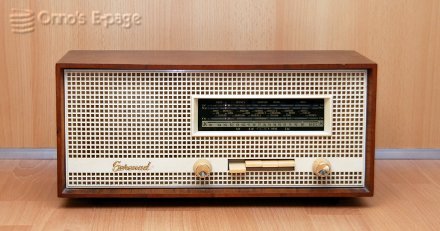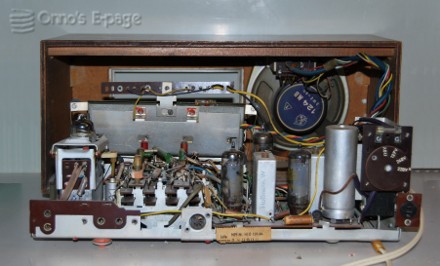RFT Stern Jalta 5360D radio (1965)


This radio has been built in the Stern factories of the DDR based RFT electronics corporation. The case is made from veneered plywood with a perforated plastic front. A simple, clean and modern design, after the scandinavian style that was in vogue at the time. Like other some Stern models, the model is named after a historically important place, Jalta for this one. My radio has the word “Serenade” on the front. This seems to be something for the export versions to Western Europe. Elsewhere on the Web you can find original DDR versions with the “Jalta” lettered on the front.
Technically, it is a typical late valve radio. It has LW, MW, SW (5.9-6.2 MHz) and FM (88-104 MHz) ranges and an input for pick-up or taperecorder. The valve line-up is:

A view of the chassis and tuning dial.
I bought this radio because when I was a child, we had exactly such a radio in our home. So though this is clearly a rather common radio, I wanted to have it.
When I tried it at home, it just worked, but there were some cosmetic points I didn't like. The pointer behind the tuning dial wasn't sitting straight, the dial illumination was irregular.
In 2009, I decided to touch up the radio. I took the chassis out of the case and took a look. Most of the electronics are on a single PCB. Interestingly, both for FM and AM, this radio uses variable inductors for tuning. The cores are attached to a kind of bascule that goes op and down when the tuning control is turned, moving the cores up and down in the inductors.
There were a number of clues to the production date of this radio. Several date codes on components pointed to January 1965. A label that seemed to identify the model, mentioned '64.

A view from the back.
I couldn't find a circuit diagram for this radio. On the radiomuseum.org site, I found a schematic of the RFT 5060 model instead, which is an AC/DC version of the 5360. I checked the supply voltage and the voltage on the anode of the output stage. These were within a reasonable range, very close to the voltages indicated on the 5060 model.
After this, I cleaned the case a bit and put the chassis back in. The radio is working fine now.
Copyright © 2009 by Onno's E-page published 2009-09-26